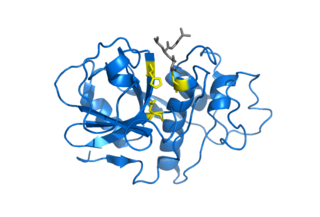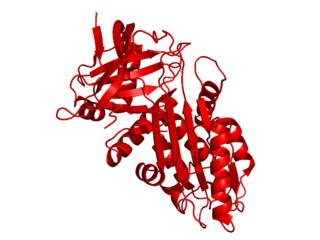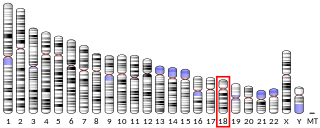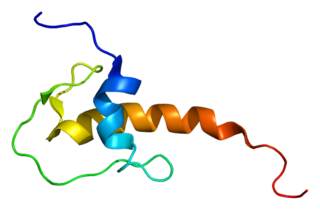
A protease is an enzyme that catalyzes proteolysis, the breakdown of proteins into smaller polypeFptides or single amino acids. They do this by cleaving the peptide bonds within proteins by hydrolysis, a reaction where water breaks bonds. Proteases are involved in many biological functions, including digestion of ingested proteins, protein catabolism, and cell signaling.
In biology and biochemistry, protease inhibitors, or antiproteases, are molecules that inhibit the function of proteases. Many naturally occurring protease inhibitors are proteins.
A metalloproteinase, or metalloprotease, is any protease enzyme whose catalytic mechanism involves a metal. An example of this would be ADAM12 which plays a significant role in the fusion of muscle cells during embryo development, in a process known as myogenesis.

Cysteine proteases, also known as thiol proteases, are hydrolase enzymes that degrade proteins. These proteases share a common catalytic mechanism that involves a nucleophilic cysteine thiol in a catalytic triad or dyad.

Caspase recruitment domains, or caspase activation and recruitment domains (CARDs), are interaction motifs found in a wide array of proteins, typically those involved in processes relating to inflammation and apoptosis. These domains mediate the formation of larger protein complexes via direct interactions between individual CARDs. CARD domains are found on a strikingly wide range of proteins, including helicases, kinases, mitochondrial proteins, caspases, and other cytoplasmic factors.

AEBSF or 4-(2-aminoethyl)benzenesulfonyl fluoride hydrochloride is a water-soluble, irreversible serine protease inhibitor with a molecular weight of 239.5 Da. It inhibits proteases like chymotrypsin, kallikrein, plasmin, thrombin, and trypsin. The specificity is similar to the inhibitor PMSF, nevertheless AEBSF is more stable at low pH values. Typical usage is 0.1 - 1.0 mM.

Leupeptin, also known as N-acetyl-L-leucyl-L-leucyl-L-argininal, is a naturally occurring protease inhibitor that can inhibit cysteine, serine and threonine peptidases.

Alpha 1-antichymotrypsin is an alpha globulin glycoprotein that is a member of the serpin superfamily. In humans, it is encoded by the SERPINA3 gene.

Serpin B3 is a protein that in humans is encoded by the SERPINB3 gene.

Serpin B4 is a protein that in humans is encoded by the SERPINB4 gene.

Lympho-epithelial Kazal-type-related inhibitor (LEKTI) also known as serine protease inhibitor Kazal-type 5 (SPINK5) is a protein that in humans is encoded by the SPINK5 gene.

Leukocyte elastase inhibitor (LEI) also known as serpin B1 is a protein that in humans is encoded by the SERPINB1 gene. It is a member of the clade B serpins or ov-serpins founded by ovalbumin.

Kallikrein-14 is a protein that in humans is encoded by the KLK14 gene.

Serpin B13 is a protein that in humans is encoded by the SERPINB13 gene.

Serpin B8 is a protein that in humans is encoded by the SERPINB8 gene.

Serpin I2 is a protein that in humans is encoded by the SERPINI2 gene.

Serpin peptidase inhibitor, clade A, member 2 is a protein that in humans is encoded by the SERPINA2 gene. Serine peptidase inhibitor, clade A member 2 belongs to the member of serine family of proteins which have a functional activity of inhibiting serine proteases.

Peptidase 1 (mite), also known as endopeptidase 1 (mite), is an enzyme found in various species of mites. This enzyme exhibits cysteine protease activity with broad endopeptidase specificity.

Serpin peptidase inhibitor, clade B (ovalbumin), member 10 is a protein that in humans is encoded by the SERPINB10 gene.

Pacifastin is a family of serine proteinase inhibitors found in arthropods. Pacifastin inhibits the serine peptidases trypsin and chymotrypsin.

















